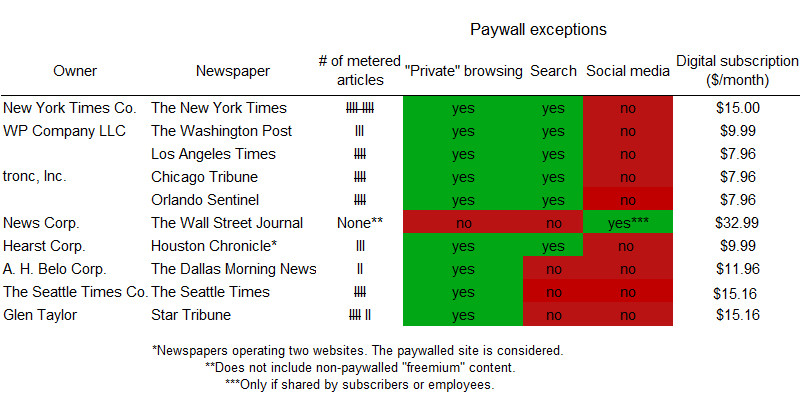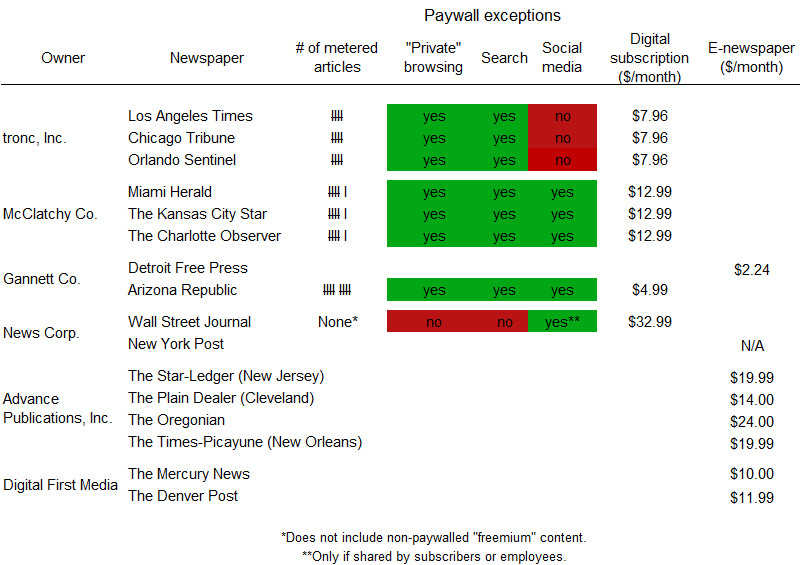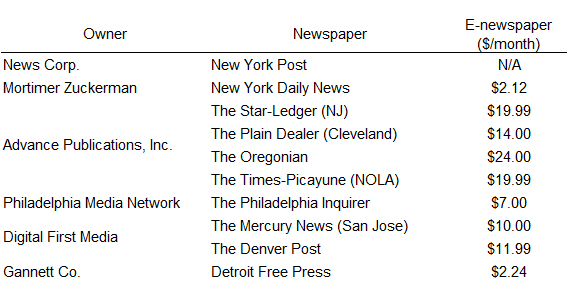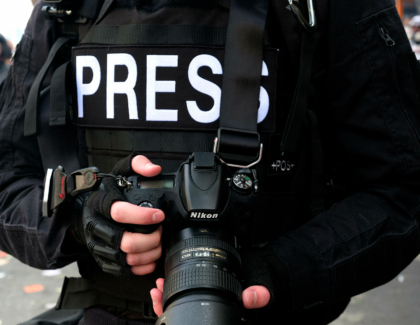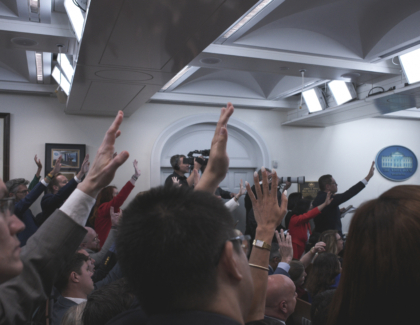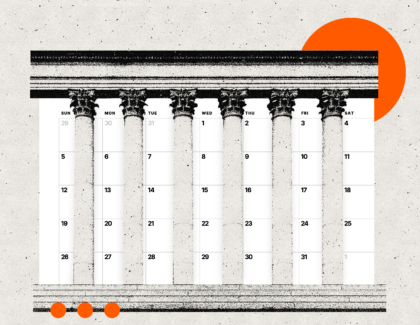Sign up for the daily CJR newsletter.
The majority of America’s largest newspapers continue to employ digital subscription strategies that prioritize traffic, ad revenues, and promotion—despite the ongoing collapse of display ad rates.
Even as they’ve added paying Web subscribers by the hundreds of thousands, daily newspapers have decisively rejected an all-in approach featuring “hard” website paywalls that mimic their print business models. Instead, most are employing either “leaky” paywalls with unlimited “side doors” for non-subscribers or no paywalls at all, according to a CJR analysis of the nation’s 25 most-visited daily newspaper sites.
There was little agreement on a paywall strategy and certainly no consensus solution to the problem of the “ideal” newspaper paywall. The paywalled news sites, 15 in total, diverged widely in the cost of their subscriptions, the number of free articles dispensed, the specific combination of “side door” exceptions employed, and whether they operated via one flagship website or two—one free and one for subscribers.
Despite what seems like widespread optimism about the prospect of digital subscriptions buttressing the industry, a full 10 sites, 40 percent of the outlets we looked at, focused on ad revenue exclusively, eschewing paywalls.
News executives who spoke with CJR expressed confidence in their company’s approach and cited their favorite figures to back it up. But without examining internal data, the best way to gauge whether they were right will be to check back in a few years and see whether each is sticking with their approach. No matter the format, the prospect of news organizations relying on paywalls as primary drivers of revenue still seems remote.
Sites with higher traffic seemed more likely to employ paywalls, though that may not be true beyond the 25 outlets we examined. Back in May, CJR analyzed paywall policies and spoke to executives at some a handful of national newspapers and magazines. They explained the goals of the “leaky” paywall with unlimited “side doors”: data gathering, promotion, and a continued central role in the public conversation.
One of the few clear patterns was that newspapers within the same ownership network had identical or nearly identical policies, with just one exception. Local factors in a newspaper’s home city seemed to play less of a role.
Here’s how our study worked.
The Alliance for Audited Media provided CJR with a list of all the daily newspapers in the US with circulation over 100,000. Comscore ranked the traffic of those paper’s websites and winnowed that list to the 25 outlets with the most-visited websites.
We visited each site. If a site had a paywall, we noted the monthly cost of a digital-only subscription. Then, through testing, we determined the number of articles allowed per month to non-subscribers, and whether the site’s paywall left open “side doors” for “private” browsing (when users set their browsers to reject tracking “cookies”), search referrals, and social media referrals. For sites without paywalls, we recorded the monthly price of a digital “e-newspaper” subscription.
(For a more detailed explanation of paywall “side doors,” see CJR’s article from May of this year on exceptions used by national newspapers and magazines).
The “leaky” paywall with “side doors”
The most common paywall strategy among the daily newspaper publishers we studied was metered access for non-subscribers with one or two unlimited “side door” exceptions. This is the model first deployed by the Times in 2011 and since adopted by The Washington Post, The Wall Street Journal, and the Tronc and Hearst stables of papers, among others.
“The metered paywall is seen as a best practice in the industry,” says Mark Campbell, Tronc’s senior vice president for digital marketing, in an interview with CJR.
Tronc’s publications all have identical subscription policies: $7.98 per month; five metered articles; exceptions for “private” browsing and search, but not social media.
The publisher transitioned to a single, company-wide policy in March 2016. Before that, each paper set its own rules. “Having one policy across all properties,” says Campbell, “we can be hyper-efficient in the ways we manage our meter rules and roll-out test results.”
Tronc is investigating the possibility of installing a metered paywall at the New York Daily News, which the company bought in early September, Campbell says. If Tronc follows through, it would be the Daily News’s first paywall in its history.
The reason Tronc publications make an exception for search referrals, Campbell explains, was to comply with Google’s First Click Free program. Google normally only indexes publically-available Web pages, that is, those not behind paywalls. With First Click Free, the search giant offers to index paywalled content as normal, so long as publishers maintain exceptions in their paywalls for readers arriving via search queries. The paywall only kicks in when the reader clicks on another story.
ICYMI: An interactive timeline of developments at Facebook
Tronc used to exempt social media referrals as well. The company changed the policy last June. The decision was “based on research and extensive testing,” Campbell says. “It’s a tradeoff between ad revenue and subscription revenue.”
More exceptions means more traffic, but less incentive for non-subscribers to subscribe. Just how much more traffic and how much less likely readers are to sign up, that’s proprietary information. And, it varies case by case.
“We don’t have want to have a ‘hard’ paywall,” Campbell says. “We’re not going to not let our readers sample the content.”
“Hard” paywalls
Of the 25 publications we studied, not one used a properly “hard” paywall such as the one The Wall Street Journal employed until last year, with no metered articles or “side doors.”
But, the Boston Globe comes closest. The paywall at BostonGlobe.com was the only one we studied that had no unlimited exceptions whatsoever. Non-subscribers get two metered articles per month, and that’s it.
“We have to figure out our own path,” Peter Doucette, the Globe’s Chief Consumer Revenue Officer, tells CJR. “We might not be able to apply the same model as the national and international publishers, because we don’t have the scale.”
The Globe also has the second most expensive digital subscription in the set, at $15.96 per month, trailing only The Wall Street Journal. “Growing our digital subscriber base is our number one corporate objective,” says Doucette.
The Globe went no-exceptions back in March, when it closed the “side door” for people using their browser’s “private” mode. “We believe that people were using [the “private” browsing exception] as a way to circumvent the paywall,” says Doucette. “We were just trying to see what would happen if we closed that loophole”
And, the experiment worked, he says. “We’ve been pretty pleased with the results. We’ve had a fair number of new subscribers coming in through that mechanism.”
The two-website, “metered freemium” model
The Globe’s emphasis on driving subscriptions over maximizing traffic at BostonGlobe.com is only half the story. Unlike the national outlets and those owned by Tronc, the Globe operates two official websites, not one.
The second site, Boston.com, is free to read and monetized entirely through advertising.
“BostonGlobe.com is the home of the Globe’s journalism digitally,” Doucette explains. “Boston.com has a separate newsroom covering similar topics, but more in a lifestyle, things-to-do, community-focused way.”
This two-site “freemium” structure, which the Globe adopted in 2011, works in some ways like the “leaky” paywall, allowing the company to pursue both subscriptions and high traffic and ad revenue at the same time.
“From a business perspective,” says Doucette, “we were able to create two different experiences that two target two distinct audiences, each with its own monetization model.”
“Boston.com is a marketing channel for the Globe,” he says, adding that the site’s primary mission was to serve readers. The overlap between the two sites’ audiences is only about 10 percent, he says.
The Houston Chronicle, owned by Hearst, also uses this metered freemium approach, with a “leaky” paywall on houstonchronicle.com, and none on chron.com. It’s worth noting both the Globe and the Chronicle switched over the last few years from a traditional “freemium” model—two sites, one free, one with a hard paywall—to their current “metered freemium” structure.
The San Francisco Chronicle, owned by Hearst, switched from a traditional “freemium” model to a straightforward “leaky” paywall in 2013.
The “very leaky” paywall
A handful of other publishers, including McClatchy and Gannett (with one exception, see below), are employing a paywall strategy at the opposite extreme to the Globe’s, leaving all three “side doors” open.
“We’ve chosen to not have a ‘hard’ wall.” says Dan Schaub, corporate director of audience development at McClatchy. “We’ve also chosen not to attack things that can be described as a workaround.”
The main reason, he explained, is promotion. Like a meter, paywall exceptions allow people to sample content. “People coming through these channels,” Schaub explains, “these are people who are not connected to your brand. But, they’re looking for content. You’re allowing them to come in through these exceptions. You’re bringing them in your front door and letting them see the kind of work you do.”
“Side door,” for the record, is not a technical term. Schaub argued that today’s paywall “abuser” could become tomorrow’s paying reader.
“You start with the assumption that most people are honest, that most people do the right thing,” Schaub says. “It’s known that we have a wall. So, if we’ve proven our value, they should subscribe.”
McClatchy’s sites also offer two weeks of paywall access for non-subscribers who create accounts. In the meantime, visitors mean traffic, and that means ad revenue. “There’s absolutely an advertising business model [online],” says Schaub, “It’d be crazy not to advertise. On the other hand, we’ve always been paid-for content.”
The no-paywall approach
A total of 10 of the 25 newspapers employed no paywall whatsoever, making all their content freely available online. Of those, all but the New York Post offered an alternative form of digital subscription, the e-newspaper. For prices ranging for $2.12 per month to $24.00 per month, site visitors can sign up to have a digitized version of the physical newspaper emailed to their inboxes seven days a week.
The Detroit Free Press offers its e-newspaper for $4.99 a month after promotions. The paper is unique among Gannett’s 109 dailies in not employing any form of paywall.
Detroit is a unique market. If it ain’t broke, you don’t fix it.”
Andy Yost, Gannett’s chief marketing officer, says the Free Press lowered its paywall in 2009 as part of the same restructuring that saw both the Free Press and the Detroit News—the city’s other major paper, which shares business management with the Free Press—significantly cut back home delivery. “It was uniquely driven by competitive forces at play in that market, pressures on the consumer revenue side, a need to meet advertising goals,” says Yost.
Incidentally, this was the only time local factors of any kind came up in our interviews. “They decided to open the paywall. That delivered audience and traffic.”
Gannett has left that policy in place since, despite the fact the company’s other 108 other newspapers operate paywalls of the “very leaky” variety described above. “Detroit is a unique market,” says Yost. “If it ain’t broke, you don’t fix it.”
The logic of the no-paywall model is straightforward, anyway. Maximize traffic, maximize advertising revenue.
Advance Publications and Digital First Media, the largest owners of no-paywall publications on our list, declined to comment for this story.
A bright digital subscription future for daily newspapers?
The daily news executives we spoke with all pushed back against suggestions of doom and gloom in the digital publishing industry. Each expressed confidence in his organization’s approach and pointed to positive recent trends in subscriber, audience, and revenue growth. They also highlighted what they saw as encouraging new trends.
“This is a good time,” says McClatchy’s Schaub.
More people, in general, are making far more purchases online, he says, in part because of the spread of more secure, more convenient payment systems. “That’s not a media world issue,” he says. “That’s a digital issue,” he says. “Consumers are becoming more comfortable with the idea that an exchange can happen and it’s safe.”
Schaub didn’t say so, but this might be especially true of newspapers readers, who tend to skew older.
Mark Aldam, president of Hearst Newspapers, whose outlets employ “leaky” paywalls, expressed optimism as well. “The menu of paid experiences [online] will continue to expand,” he says, referring to digital products in general, including news. “The possibility for success in the paid digital economy is on the rise.”
Aldam also pointed to what he says were major improvements in reader data collection and, consequently, in the industry’s ability to target its promotion and advertising.
“The big change is we’re getting a background,” he says. “We’re collecting data and marketing information. That’s been a huge deficiency for all of us. That could alter the basic relationship we have with our readers.”
For now, though, as far as digital subscriptions, a large part of the daily newspaper industry still seems to be experimenting.
RELATED: We tested paywalls at NYTimes, WSJ & WashPo and more. All of them were pretty leaky, except one.
Has America ever needed a media defender more than now? Help us by joining CJR today.





